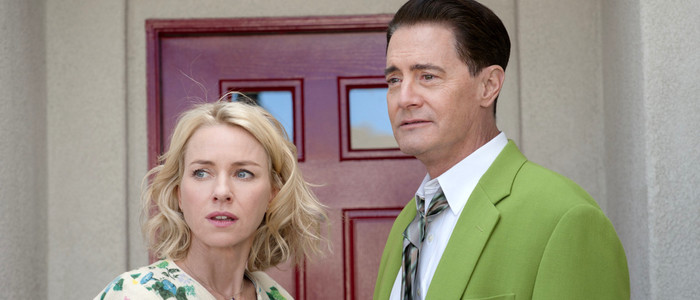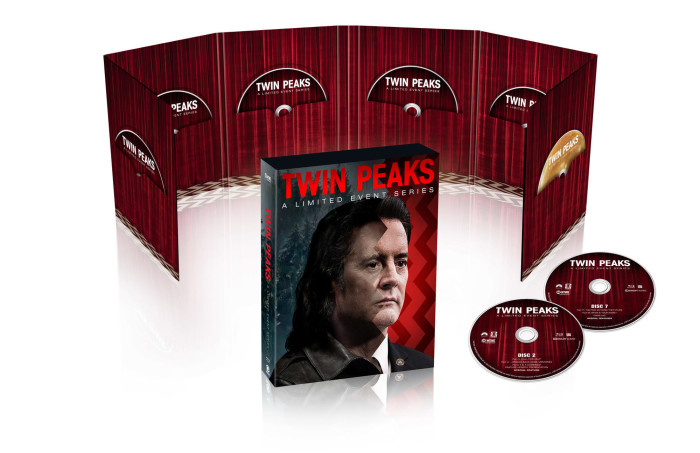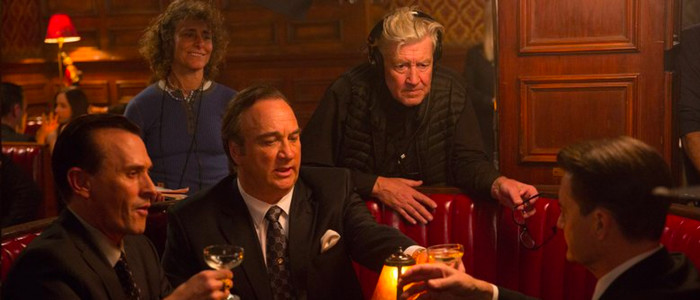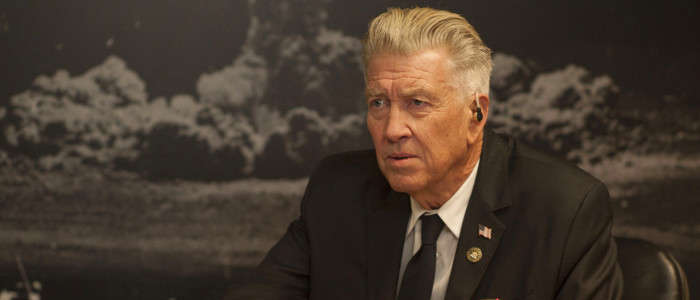The 'Twin Peaks' Season 3 Blu-Ray Is A Wonderful Package For 2017's Greatest Piece Of Narrative Entertainment
David Lynch's stunning Twin Peaks season 3, also known as Twin Peaks: The Return, comes to Blu-ray as a must-have box set loaded with fascinating and revealing looks behind the production. Just as they did so many years ago, David Lynch and Mark Frost have created a TV event unlike any other before, and probably unlike anything that will ever come after it. Here, as one cohesive Blu-ray, we have the chance to watch the saga unfold from beginning to end, which might very well be the best way to experience the show. Our Twin Peaks season 3 Blu-ray review below pulls back the red curtain and journeys into the unknown. Join me?Note: this first page will discuss the season as a whole and includes major spoilers. For discussion about the Blu-ray package itself and the special features, scroll on down and head to the next page.
The Owls Are Not What They Seem
The greatest piece of narrative entertainment from 2017 was not in movie theaters, but rather playing on Showtime over the course of one weird, wild summer. Defying the odds, premium cable channel Showtime parked a large amount of money on David Lynch's doorstep and convinced him to come out of semi-retirement to resurrect his cult TV series Twin Peaks. The results were stunning.Lynch, the brilliant, mad mind behind Blue Velvet, Lost Highway and more, hadn't made a film since 2006's Inland Empire, yet any fears that the iconic filmmaker might have grown rusty in his time off were quickly assuaged as the beginning of the new Twin Peaks unfolded. Lynch and Twin Peaks co-creator Mark Frost had pulled out all the stops to return audiences to a place both wonderful and strange, and we all got a lot more than we could've possibly bargained for.The importance of the original Twin Peaks can not be overstated. TV as we know it today, everything we lump into the "Peak TV" category of high quality, cinematic television, can trace its roots back to what Lynch and Frost did with the original Twin Peaks. He brought the auteur theory and the avant-garde to mainstream primetime TV, and television has been paying tribute ever since. The original Peaks only lasted two seasons, but after its cancellation in 1991, the show took on a life of its own, its cult fandom growing to monolithic proportions. Lynch revisited the town with 1992's prequel film Twin Peaks: Fire Walk With Me, which polarized audiences and took the mythology of the series into even stranger, near-indecipherable directions. Something curious happened after that: the show became even more popular, but the show that newer fans seemed to latch onto wasn't actually the show that Lynch had created.A meme-ification of Twin Peaks had set in, fueled by the Tumblr generation fond of sharing out of context screen grabs and quick gifs that may look amazing but don't even come close to capturing the aura of what Lynch was going for. So when Lynch and Frost announced that "That gum you like is going to come back in style," there was an uneasiness with how modern TV viewers would react to whatever it was they were about to witness. We live in the age of the live-tweet, where audiences have trouble putting their phone down to entirely focus on their entertainment, and are instead prone to firing off an instant reaction with the hopes of raking up a few "likes." This is not the ideal type of viewing experience for something created by Lynch, and if audiences thought they were going to be in for instant gratification with the new Twin Peaks, they were setting themselves up for failure.The same foul fate would befall the aforementioned Tumblr generation, who apparently wanted nothing deeper than endless shots of cherry pie, black coffee, and Audrey Horne's saddle shoes. Anyone who dares to cruise the Twin Peaks hashtag on Tumblr while the new series was airing likely found themselves in a world of woe, with Tumblr users bemoaning that the new Twin Peaks was denying them their dream of Special Agent Dale Cooper and Audrey Horne finally falling into each other's arms at the Double R Diner while Shelly Johnson serves them up a slice of pie. In short, what they wanted was fan service. And fan service is not what David Lynch traffics in. I doubt the term even exists in his vocabulary.Instead, Lynch provided viewers with one of the most audacious 18 hours ever committed to television. A daring, mind-warping journey back to the town of Twin Peaks and beyond. He blew a big, black hole into the very mythology of the show, and created something stranger than anyone viewing the original series would've imagined.
I Am Dead Yet I Live
The original Twin Peaks began as a procedural drama, then blossomed into something nearly unclassifiable. After local teen Laura Palmer (Sheryl Lee) is found murdered, FBI Agent Dale Cooper (Kyle MacLachlan) arrives in town to investigate. Cooper gets to know the town, and the townsfolk, as he tries to crack the Palmer case.And then things get weird.Twin Peaks made what many consider to be a huge mistake by wrapping up the mystery of who killed Laura Palmer rather quickly, and then becoming stranger and stranger until it found itself cancelled. The problem: the series ended on one major cliffhanger, with Cooper trapped in The Black Lodge, an eerie, extra-dimensional location populated with backwards-talking people, billowing red curtains and flashes of lighting. Meanwhile, an evil Cooper doppelgänger, connected to the malevolent force known as BOB, took the real Cooper's place back in the real world.There was never any real chance that Lynch and Frost would quickly sew up this dangling thread, however. Instead, when Twin Peaks returned to Showtime, it expanded the mythology of the series and took viewers on a long journey that was all part of Cooper's return to the real world. But Cooper isn't the real focus of Twin Peaks. Laura Palmer is. For Lynch, Laura Palmer is a representation of horribly wronged innocence. Fire Walk With Me revealed the traumatic events leading up to Laura's death, and Lynch's focus seems to be on the cosmic injustice of it all. The cruel blindness of fate. Laura Palmer is a force of something pure and good in the universe, and no matter how hard Cooper might try, he can never really save her. But perhaps that's not what's important. Perhaps what's important is that he'll keep trying.Twin Peaks season 3 has Cooper escape the Black Lodge by taking the place of hapless, corrupt Las Vegas dwelling insurance salesman Dougie Jones (also played by MacLachlan). In reality, Dougie is a "tulpa" – a being created from the selected thoughts of different individuals. Tibetan mythology describe tulpas as "extra bodies that were created from one person's mind in order to travel to spiritual realms."Rather than have Cooper escape the Black Lodge and come back to the real world acting like his old self, Lynch and Frost have the agent stuck in a childlike state, as if all the years stuck in an alternate dimension has blasted away a part of his consciousness. Then, in the most delightfully devious twist of all, Lynch proceeds to keep Cooper in this state through nearly the entire series. There are triggers that we keep expecting will snap Cooper out of his Dougie state: coffee, pie, etc. But Lynch isn't interested in an easy way out. Instead, he engrosses us into the life of Dougie Jones, as the traumatized Cooper adapts to his new reality with Dougie's wife Janey-E (Naomi Watts) and son Sonny Jim (Pierce Gagnon).You could practically hear the groans of certain viewers as Lynch refused to break Cooper out of the Jones family mold, yet this material provides us with some of the most incredible moments of the revival series, and gives Kyle MacLachlan a chance to shine, playing up both the comic relief elements of Dougie Jones (see: Dougie in a casino yelling "Hello-oooooo!" at slot machines) mixed with more heartbreaking scenes (see: Dougie watching Sonny Jim with a look of profound sadness on his face).Twin Peaks sets up a horde of new characters, almost all of which become memorable almost instantaneously – a feat few other shows can pull off. There's the Mitchum Brothers (Jim Belushi and Robert Knepper), who are both trying to murder Dougie Jones before growing fond of him on the basis of a dream. There are two assassins (Jennifer Jason Leigh and Tim Roth), who spend most of their time in a van shooting the breeze when they're not shooting people. And most important of all, there's Diane (Laura Dern), Cooper's old flame who teams up with FBI Director Gordon Cole (Lynch) and company to find out what happened to the real Cooper. Dern, with her various wigs, foul mouth, chain smoking and multi-colored manicure, steals every scene she appears in.But what of Twin Peaks, the town that started it all? Lynch brings us back to the town, and gives us a glimpse into the lives of old favorites: Shelly (Mädchen Amick), Bobby (Dana Ashbrook), Big Ed (Everett McGill), Norma (Peggy Lipton), Andy (Harry Goaz), Lucy (Kimmy Robertson), Hawk (Michael Horse), Audrey Horne (Sherilyn Fenn), and more, but the new season isn't so much interested in closing out their stories as it is showing the effects of the passage of time. That's not to say there aren't narrative conclusions. In one of the new season's most satisfying moments, Big Ed and Norma finally seal the deal on their romance after years apart. Lynch stages this in a lovely way, with Norma's hands coming from just off frame onto Big Ed's shoulders, while Big Ed closes his eyes in contentment.These lovely moments are contrasted with stark, disturbing horror. In the opening episode alone, a nameless, shapeless monster escapes a containment unit and lays waste to a pair of lovers in a scene drenched in blood and confusion. And at the center of the series as a whole is the terrifying notion that evil, in all its forms, will almost always come out ahead. After nearly 18 hours, Cooper manages to alter time and save Laura Palmer from her teenage demise. Yet the aftershocks of this change are not ideal – the world as Cooper (and by extension, the audience) knows it has been altered forever. The final few seconds of the series find Cooper and Laura in a state of limbo, with Cooper absently wondering "What year is this?" before Laura, looking up at the house that once held such trauma and abuse for her in another life, emits a piercing, blood-chilling scream that seems to be echoing across time and space itself (note: if there was an award for Best Scream, Sheryl Lee would be the clear winner).What are we to make of this cryptic, haunting conclusion? The beauty of Twin Peaks is that Lynch and Frost aren't interested in providing us with clear answers. One of the quotes from the revival series states, "We are like the dreamer who dreams and lives inside the dream." This is as clear a Twin Peaks mission statement as we'll ever receive. The series as a whole is a dream that the audience is living inside, and like dreams, the narrative is open to endless interpretation. And best of all, no interpretation can really be considered incorrect. You can take away a million different morals from Twin Peaks as a whole, but I think a strong case can be made for the unsettling message that evil – in all its forms – will frequently come out ahead. The important thing is for committed, determined people like Dale Cooper to continue to try to stop it anyway. Cooper may not always succeed, but we can take some sort of cold comfort in the fact that he'll try anyway.
Phenomenon
The Blu-ray special feature Phenomenon is broken into three distinct parts: Creation, Life After Death and Renaissance. As a whole, this feature is a fun but mostly boilerplate look at the series as a whole. It's quick and to the point, and was likely originally cut to serve as more of a commercial for the revival series than a truly in-depth look at Twin Peaks. Creation looks at the show's origins, from its time on ABC to the fan reaction, including the popular "watching parties" that had audiences coming together to experience each weekly episode as a group. Life After Death examines the growing cult fandom that sprung up after the show had been cancelled. Fan magazines and conventions gave Twin Peaks a whole new life, and kept the series alive for an entire new generation born after the first show had long been cancelled. Renaissance is a crash-course in bringing the show back to life on Showtime. Again, there's no real insight here, or depth. Lynch and frost pop-up for quick soundbites, but anyone hoping for the creators to delve into the process of bringing Twin Peaks back from the dead need look elsewhere.
Behind the Red Curtain and I Had Bad Milk in Dehradun
Richard Beymer, who plays Twin Peaks character Ben Horne, shot these two mini-documentaries that appear in the Blu-ray special features. There's no narrative thread to these two features. Instead, they provide a raw, uncensored look at Lynch and company on the Black Lodge set, setting up shots. These two features provide us with what will become a running theme of the behind-the-scenes footage provided on the Blu-ray: shot after shot of Lynch at work.If you ever wanted to sit back and watch David Lynch direct, the features provided here are a gold mine. They also provide an amusing, even charming look at how normal it all is. Lynch deals with such strange, dark, violent material that it can be easy to think of him as a dark, brooding weirdo, but the footage here shows him as an affable, laid-back fellow who knows exactly what he wants from a scene and how to get it. These slice-of-life moments give us an opportunity to see Lynch help Kyle MacLachlan tie a necktie, or give Sherilyn Fenn a cigarette as he talks with her about her character. Speaking of cigarettes, get ready to see a lot of them. Lynch is constantly smoking in these behind-the-scenes moments, an American Spirit cigarette always perched in his mouth or resting between his fingers. Don't be surprised if you find yourself longing for a smoke after watching all of this.The only downside to this, and other behind-the-scenes features, is that some of the magic of the show is lost. We're peeling back the red curtain here, and seeing how the sausage is made. The otherworldly nature of Twin Peaks drops away as we see numerous crew members making everything come together. In one amusing moment, we see Lynch and company watching a clip from the original Twin Peaks on YouTube so they can match a shot up to a new scene.
In A Very Lovely Dream: One Week in Twin Peaks
Filmmaker Charles DeLauzirika put together this on-location feature that goes behind the scenes. Not much of the material here is very comprehensive, but it does provide a fly-on-the-wall look at the production, including actors discussing how strange it was to step back into roles they hadn't played in more than two decades. The best moments come when we get to watch Lynch direct – almost always through a megaphone. If you're looking for a bit more, however, this isn't the feature for you. Instead, you should move quickly to IMPRESSIONS: A Journey Behind the Scenes of Twin Peaks.
IMPRESSIONS: A Journey Behind the Scenes of Twin Peaks
Without question, the best features on the new Twin Peaks: A Limited Event Series Blu-ray release are the series of behind-the-scenes films bundled together as IMPRESSIONS: A Journey Behind the Scenes of Twin Peaks. Longtime Lynch documentarian and friend Jason S. shot these 10 revealing, fascinating films (each runs about 30 minutes), covering almost the entire filming schedule of the new series.Once again, we have Lynch constantly smoking his American Spirit cigarettes, but these features are much more in-depth than Behind the Red Curtain and I Had Bad Milk in Dehradun. We get to watch as Lynch and his crew come up with character names on the fly, and cracking up when he thinks up silly-sounding names. This feature also reveals how hands-on Lynch is: at one point, we see him sculpting one of the show's props himself – a spout made of styrofoam that will eventually serve as the giant teapot-like contraption that took the place of the dearly departed David Bowie.Again, the best moments are those when we get to watch Lynch direct, like a sequence where he chats with Kyle MacLachlan and Laura Dern in a motel room set. Lynch has nicknames for all his actors, and it's charming to listen to him refer to Dern as "Tidbit" and MacLachlan as "Kale." Later, he has to talk Dern into letting makeup artists cover her face in bread dough. After the scene is complete, Dern gets payback by applying the same dough to Lynch's face. It's a charming, funny glimpse into the carefree, friendly atmosphere prevalent on Lynch's sets. "I wouldn't have a career if it wasn't for David," MacLachlan said once. "He pretty much brought me up in the film world and spoiled me; we've all spoken about how the set is, he creates the environment and the joyfulness and the creativity. I've been spoiled forever working with David." The footage here is proof positive of that statement.Still, there are moments where Lynch can lose his temper. In one sequence, not filmed on set but rather in a meeting with his crew, Lynch gets frustrated when he's told that they'll only be able to film in one location for two days. The filmmaker grows apoplectic at this time constraint, shouting, "Why do I only have two fucking days?" and complaining that given the chance, he could spend "weeks" on certain sets "dreaming up new ideas."The only negative thing I'll say about this feature: the footage is (sporadically) narrated by Josef Maria Schäfers, in what I presume is an attempt to mock (or perhaps pay loving tribute to) the existential narration that filmmaker Werner Herzog usually gives his documentaries. The narration here is unnecessary and distracting, and grows truly tiresome after a while.
Goodbye, Margaret
Other features on the Blu-ray include a series of David Lynch produced promos for the series. Lynch managed to avoid having to cut a proper trailer for the Showtime revival, and instead put together these abstract clips that teased the tone without giving anything away. Also included is a behind-the-scenes photo gallery, a series of alternating versions of the Rancho Rosa production logo that started each episode, and the full San Diego Comic-Con 2017 Twin Peaks Panel, which you can watch in full above.
As a whole, the Twin Peaks: A Limited Event Series Blu-ray is a must-own for any David Lynch or Twin Peaks fan. There's a wealth of material here beyond the series itself, but best of all is the opportunity to watch the episodes back-to-back, and watch as the create an elaborate, hypnotic saga the likes of which we'll never see again.Full list of special features:BLU-RAY AND DVD:
BLU-RAY EXCLUSIVE:
